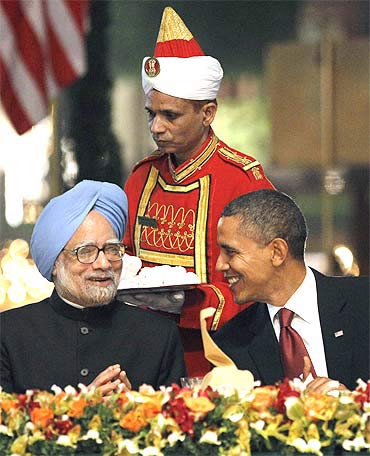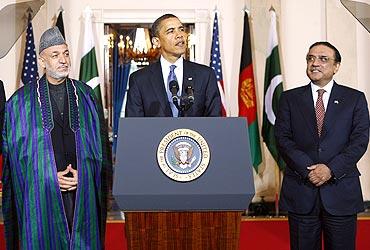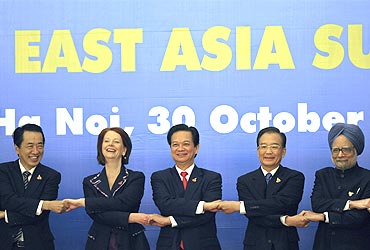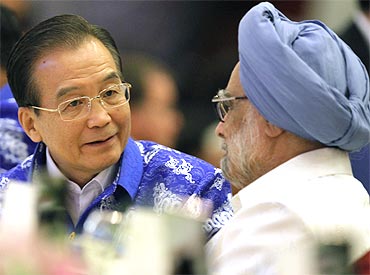 | « Back to article | Print this article |
Why Obama visit is significantly successful
A comprehensive roadmap for giving shape to the Indo-US strategic partnership has been the most important outcome of the very successful visit of United States President Barack Obama to India, notes strategic expert B Raman
The details of this roadmap are to be found in the joint statement issued by Prime Minister Manmohan Singh and President Obama on the conclusion of his visit.
The basic foundation of this strategic partnership will be "the shared values and increasing convergence of interests" between the two countries. This convergence of interests relates to shared security as well as shared prosperity."
Click NEXT to read further..
'Singh and Obama have laid down a comprehensive architecture for the partnership'
The joint statement said: "The two leaders reaffirmed that India-US strategic partnership is indispensable not only for their two countries but also for global stability and prosperity in the 21st century."
To that end, President Obama welcomed India's emergence as a major regional and global power and affirmed his country's interest in India's rise, its economic prosperity, and its security.
The joint statement and the President's well-drafted address to a joint session of the Parliament on Monday sought to remove Indian misgivings that he had diluted the importance given by his predecessor George Bush to the Indo-US Strategic Partnership.
The partnership as projected by the previous Goerge Bush administration was vague in concepts and weak in details. Manmohan Singh and Obama have sought to strengthen the conceptual framework of the partnership and lay down a comprehensive architecture for the partnership.
'The partnership to promote peace and stability across Asia'
The framework and architecture envisaged by them will have regional, global and bilateral dimensions. The regional dimensions will be, firstly, deepening existing regular strategic consultations on developments in East Asia, and expanding and intensifying their strategic consultations to cover regional and global issues of mutual interest, including Central and West Asia.
Secondly, intensifying consultation, cooperation and coordination to promote a stable, democratic, prosperous, and independent Afghanistan and pursuing joint development projects with the Afghan government in capacity building, agriculture and women's empowerment. These joint projects will supplement the individual projects of the two countries.
Thirdly, in an indirect reference to regional concerns over the Chinese assertiveness in the South and East China Seas and the perceived lack of transparency in Chinese policies, the statement said: "In an increasingly inter-dependent world, the stability of, and access to, the air, sea, space, and cyberspace domains is vital for the security and economic prosperity of nations."
Acknowledging their commitment to openness and responsible international conduct, and on the basis of their shared values, India and the United States have launched a dialogue to explore ways to work together, as well as with other countries, to develop a shared vision for these critical domains to promote peace, security and development.
The leaders reaffirmed the importance of maritime security, unimpeded commerce, and freedom of navigation, in accordance with relevant universally agreed principles of international law, including the United Nations Convention on the Law of the Sea, and peaceful settlement of maritime disputes.
Thus, the partnership will seek to promote peace and security across Asia in general and in East and Central Asia in particular, strengthen maritime security and work for a peaceful settlement of maritime disputes. Though China has not been named, Beijing will have reasons to be concerned over the implications of this formulation.Time for India to engage in broader global issues
The global dimensions seek to provide an enhanced role for India as a global power. Obama emphsasised on more than one occasion that India can no longer be charactertised as an emerging power as the Bush administration used to do, but is already a global power.
India's enhanced role as a global power will be assured through the following actions with the support of the US:
Firstly, India's eventual permanent membership of the United Nations Security Council as part of the reforms in the UN structure. This amounts to the US agreeing in principle to India's permanent membership, but no time-line has been indicated.
There is also a lack of clarity on the issue as to whether the US wants India to be a permanent member with full veto rights on par with China and the other four permanent members.
The United States intends to support India's full membership in the four multilateral export control regimes (Nuclear Suppliers Group, Missile Technology Control Regime, Australia Group, and Wassenaar Arrangement) in a phased manner, and to consult with regime members to encourage the evolution of regime membership criteria, consistent with maintaining the core principles of these regimes, as the government of India takes steps towards the full adoption of the regimes' export control requirements to reflect its prospective membership, with both processes moving forward together.
In the view of the United States, India should qualify for membership in the Australia Group and the Wassenaar Arrangement according to existing requirements once it imposes export controls over all items on these regimes' control lists."
The 'global' Indo-US ties
They agreed to work together in the G-20 to make progress on the broad range of issues on its agenda, including by encouraging actions consistent with achieving strong, balanced, and sustainable growth, strengthening financial system regulation, reforming the international financial institutions, enhancing energy security, resisting protectionism in all its forms, reducing barriers to trade and investment, and implementing the development action plans.
"The leaders launched a US-India Open Government Dialogue that will, through public-private partnerships and use of new technologies and innovations, promote their shared goal of democratising access to information and energising civic engagement, support global initiatives in this area and share their expertise with other interested countries.
This will build on India's impressive achievements in this area in recent years and the commitments that the President made to advance an open government agenda at the United Nations General Assembly.
The President and Prime Minister also pledged to explore cooperation in support of efforts to strengthen elections organisation and management in other interested countries, including through sharing their expertise in this area.
Taking advantage of the global nature of their relationship, and recognising India's vast development experience and historical research strengths, the two leaders pledged to work together, in addition to their independent programmes, to adapt shared innovations and technologies and use their expertise in capacity building to extend food security to interested countries, including in Africa, in consultation with host governments.
How China can be the 'spoiler' in this bonhomie
The concretisation of the first two actions relating to the UN Security Council and multilateral export control regimes is likely to take time because of the possibility of Chinese opposition, partly for their own reasons and partly at the instigation of Pakistan.
The idea of joint Indo-US projects in Africa will also cause concern in China which has been very active in Africa.
The Joint Statement sums up the bilateral dimension as follows: "Recognizing that India and the United States should play a leadership role in promoting global nonproliferation objectives and their desire to expand high technology cooperation and trade, Prime Minister Singh and President Obama committed to work together to strengthen the global export control framework and further transform bilateral export control regulations and policies to realise the full potential of the strategic partnership between the two countries.
Accordingly, the two leaders decided to take mutual steps to expand US-India cooperation in civil space, defense, and other high-technology sectors.
Commensurate with India's nonproliferation record and commitment to abide by multilateral export control standards, these steps include the United States removing Indian entities from the US Department of Commerce's "Entity List" and realignment of India in US export control regulations."
My over-all expectation is that while the regional and bilateral dimensions, which depend only on the two countries, can be concretised in the short and medium terms, the global dimensions will face likely hurdles from China before their concretisation.





